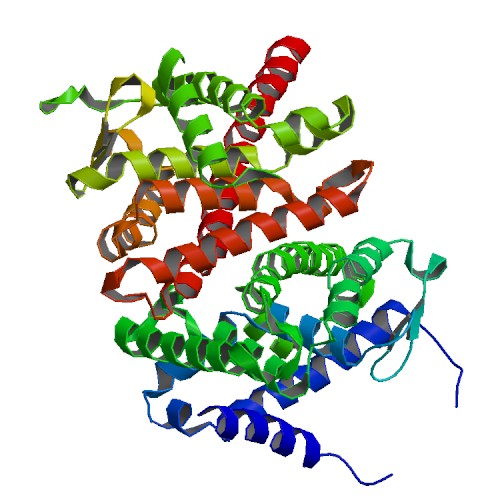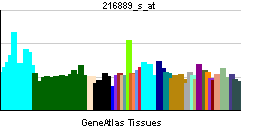Hepatocyte nuclear factor 4 alpha
| Hepatocyte nuclear factor 4, alpha | |||||||||||||
|---|---|---|---|---|---|---|---|---|---|---|---|---|---|
 PDB rendering based on 1m7w. | |||||||||||||
| |||||||||||||
| Identifiers | |||||||||||||
| Symbols | HNF4A ; FLJ39654; HNF4; HNF4a7; HNF4a8; HNF4a9; MODY; MODY1; NR2A1; NR2A21; TCF; TCF14 | ||||||||||||
| External IDs | Template:OMIM5 Template:MGI HomoloGene: 395 | ||||||||||||
| |||||||||||||
| RNA expression pattern | |||||||||||||
 | |||||||||||||
 | |||||||||||||
 | |||||||||||||
| More reference expression data | |||||||||||||
| Orthologs | |||||||||||||
| Template:GNF Ortholog box | |||||||||||||
| Species | Human | Mouse | |||||||||||
| Entrez | n/a | n/a | |||||||||||
| Ensembl | n/a | n/a | |||||||||||
| UniProt | n/a | n/a | |||||||||||
| RefSeq (mRNA) | n/a | n/a | |||||||||||
| RefSeq (protein) | n/a | n/a | |||||||||||
| Location (UCSC) | n/a | n/a | |||||||||||
| PubMed search | n/a | n/a | |||||||||||
Hepatocyte nuclear factor 4 alpha (HNF4A) also known as NR2A1 (nuclear receptor subfamily 2, group A, member 1) is a nuclear receptor encoded by the HNF4A gene.
The protein encoded by this gene is a nuclear transcription factor which binds DNA as a homodimer. The encoded protein controls the expression of several genes, including hepatocyte nuclear factor 1 alpha, a transcription factor which regulates the expression of several hepatic genes. This gene may play a role in development of the liver, kidney, and intestines. Mutations in this gene have been associated with monogenic autosomal dominant non-insulin-dependent diabetes mellitus type I. Alternative splicing of this gene results in multiple transcript variants.[1]
See also
References
Further reading
- Winter WE, Nakamura M, House DV (2000). "Monogenic diabetes mellitus in youth. The MODY syndromes". Endocrinol. Metab. Clin. North Am. 28 (4): 765–85. PMID 10609119.
- Zannis VI, Kan HY, Kritis A; et al. (2001). "Transcriptional regulation of the human apolipoprotein genes". Front. Biosci. 6: D456–504. PMID 11229886.
- Gupta RK, Kaestner KH (2005). "HNF-4alpha: from MODY to late-onset type 2 diabetes". Trends in molecular medicine. 10 (11): 521–4. doi:10.1016/j.molmed.2004.09.004. PMID 15519277.
- Mohlke KL, Boehnke M (2005). "The role of HNF4A variants in the risk of type 2 diabetes". Curr. Diab. Rep. 5 (2): 149–56. PMID 15794920.
- Love-Gregory L, Permutt MA (2007). "HNF4A genetic variants: role in diabetes". Current opinion in clinical nutrition and metabolic care. 10 (4): 397–402. doi:10.1097/MCO.0b013e3281e3888d. PMID 17563455.
- Bell GI, Xiang KS, Newman MV; et al. (1991). "Gene for non-insulin-dependent diabetes mellitus (maturity-onset diabetes of the young subtype) is linked to DNA polymorphism on human chromosome 20q". Proc. Natl. Acad. Sci. U.S.A. 88 (4): 1484–8. PMID 1899928.
- Ktistaki E, Ktistakis NT, Papadogeorgaki E, Talianidis I (1995). "Recruitment of hepatocyte nuclear factor 4 into specific intranuclear compartments depends on tyrosine phosphorylation that affects its DNA-binding and transactivation potential". Proc. Natl. Acad. Sci. U.S.A. 92 (21): 9876–80. PMID 7568236.
- Ginsburg GS, Ozer J, Karathanasis SK (1995). "Intestinal apolipoprotein AI gene transcription is regulated by multiple distinct DNA elements and is synergistically activated by the orphan nuclear receptor, hepatocyte nuclear factor 4". J. Clin. Invest. 96 (1): 528–38. PMID 7615825.
- Jiang G, Nepomuceno L, Hopkins K, Sladek FM (1995). "Exclusive homodimerization of the orphan receptor hepatocyte nuclear factor 4 defines a new subclass of nuclear receptors". Mol. Cell. Biol. 15 (9): 5131–43. PMID 7651430.
- Chartier FL, Bossu JP, Laudet V; et al. (1994). "Cloning and sequencing of cDNAs encoding the human hepatocyte nuclear factor 4 indicate the presence of two isoforms in human liver". Gene. 147 (2): 269–72. PMID 7926813.
- Drewes T, Senkel S, Holewa B, Ryffel GU (1996). "Human hepatocyte nuclear factor 4 isoforms are encoded by distinct and differentially expressed genes". Mol. Cell. Biol. 16 (3): 925–31. PMID 8622695.
- Yamagata K, Furuta H, Oda N; et al. (1997). "Mutations in the hepatocyte nuclear factor-4alpha gene in maturity-onset diabetes of the young (MODY1)". Nature. 384 (6608): 458–60. doi:10.1038/384458a0. PMID 8945471.
- Kritis AA, Argyrokastritis A, Moschonas NK; et al. (1996). "Isolation and characterization of a third isoform of human hepatocyte nuclear factor 4". Gene. 173 (2): 275–80. PMID 8964514.
- Argyrokastritis A, Kamakari S, Kapsetaki M; et al. (1997). "Human hepatocyte nuclear factor-4 (hHNF-4) gene maps to 20q12-q13.1 between PLCG1 and D20S17". Hum. Genet. 99 (2): 233–6. PMID 9048927.
- Thénot S, Henriquet C, Rochefort H, Cavaillès V (1997). "Differential interaction of nuclear receptors with the putative human transcriptional coactivator hTIF1". J. Biol. Chem. 272 (18): 12062–8. PMID 9115274.
- Bulman MP, Dronsfield MJ, Frayling T; et al. (1997). "A missense mutation in the hepatocyte nuclear factor 4 alpha gene in a UK pedigree with maturity-onset diabetes of the young". Diabetologia. 40 (7): 859–62. PMID 9243109.
- Møller AM, Urhammer SA, Dalgaard LT; et al. (1998). "Studies of the genetic variability of the coding region of the hepatocyte nuclear factor-4alpha in Caucasians with maturity onset NIDDM". Diabetologia. 40 (8): 980–3. PMID 9267996.
- Lindner T, Gragnoli C, Furuta H; et al. (1997). "Hepatic function in a family with a nonsense mutation (R154X) in the hepatocyte nuclear factor-4alpha/MODY1 gene". J. Clin. Invest. 100 (6): 1400–5. PMID 9294105.
- Furuta H, Iwasaki N, Oda N; et al. (1997). "Organization and partial sequence of the hepatocyte nuclear factor-4 alpha/MODY1 gene and identification of a missense mutation, R127W, in a Japanese family with MODY". Diabetes. 46 (10): 1652–7. PMID 9313765.
- Stoffel M, Duncan SA (1998). "The maturity-onset diabetes of the young (MODY1) transcription factor HNF4alpha regulates expression of genes required for glucose transport and metabolism". Proc. Natl. Acad. Sci. U.S.A. 94 (24): 13209–14. PMID 9371825.
This article incorporates text from the United States National Library of Medicine, which is in the public domain.
| This protein-related article is a stub. You can help Wikipedia by expanding it. |